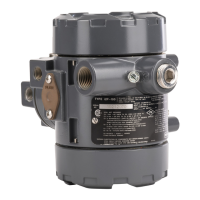Instruction Manual
D103198X012
i2P-100 Transducer
July 2014
9
Special Conditions for Safe Use
Intrinsically Safe
1. Before putting in service, the user shall permanently cross out the areas on the nameplate with the types of
protection that are not applicable (Ex ia IIC T3... T5, KEMA 05ATEX1109 X or Ex nA II T5/T6, KEMA 05ATEX1119) or
mark the selected type of protection. Once determined the type of protection may not be changed.
2. Because the enclosure of the i2P‐100 transducer is made of aluminum, if it is mounted in an area where the use of
category 1 G apparatus is required, it must be installed such, that, even in the event of rare incidents, ignition
sources due to impact and friction sparks are excluded.
3. Ambient temperature range:
-40_C - + 46_C for temperature class T5
-40_C - + 81_C for temperature class T4
-40_C - + 85_C for temperature class T3
Electrical data:
Unit must be installed with appropriate I.S barrier with maximum entity ratings as follows:
Ui = 30 V ; Ii = 100 mA (resistively limited) ; Pi = 1 W ; Ci = 0 nF ; Li = 0 mH
Flameproof
1. Before putting in service, the user shall permanently cross out the areas on the nameplate with the types of
protection that are not applicable (Ex ia IIC T3... T5, KEMA 05ATEX1109 X or Ex nA II T5/T6, KEMA 05ATEX1119) or
mark the selected type of protection. Once determined the type of protection may not be changed.
2. Electrical connections are typically made using either cable or conduit.
D If using a cable connection, the cable entry and closing devices shall be certified in type of protection flameproof
enclosure “d”, suitable for the conditions of use and correctly installed. For ambient temperatures over 70_C,
suitable heat resistant cables and cable glands shall be used.
D If using a rigid conduit connection, a certified sealing device in type of protection flameproof enclosure “d”, such
as a conduit seal with setting compound shall be provided immediately to the entrance of the valve housing. For
ambient temperature over 70_C, suitable heat resistant wiring and setting compound for the conduit seal shall
be used.
Type n
1. Before putting in service, the user shall permanently cross out the areas on the nameplate with the types of
protection that are not applicable (Ex ia IIC T3... T5, KEMA 05ATEX1109 X or Ex nA II T5/T6, KEMA 05ATEX1119) or
mark the selected type of protection. Once determined the type of protection may not be changed.
Refer to table 7 for additional information and figure 18 for a typical ATEX/IECEx approval nameplate.

